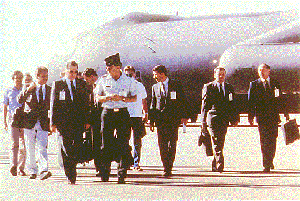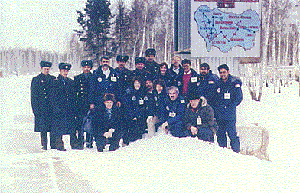| The United States had fewer missile sites, but distances were similar. For example, the On-Site Inspection Agency was responsible for getting the Soviet inspection teams from Dulles International Airport in Washington, D.C., to one of five INF sites in the eastern half of the United States within nine hours. Those sites were in Oklahoma, Alabama, Florida, Texas, and Maryland. Only the site at the Martin Marietta plant in Middle River, Maryland, was readily accessible to Dulles International Airport. The other American INF sites--at Fort Sill, Oklahoma; Redstone Arsenal, Alabama; Longhorn Army Ammunition Plant, Texas: and Complex 16, Cape Canaveral, Florida, required a combination of air and bus travel to get the Soviet inspectors to the site within the treaty timelines.5 In Europe, OSIA's escort teams, operating from the agency's field office in Frankfurt, faced equally stringent timelines. The United States had 12 INF missile operating bases and facilities in five Western European nations: Great Britain, West Germany, Italy, Belgium, and the Netherlands. Each of these nations had a treaty-designated point of entry to which Soviet inspection teams would fly before declaring the site to be inspected. The Soviet teams had to be met by a U.S. INF escort team, which was responsible for arranging air and ground transportation to get the Soviet inspectors from the airport to the American INF site within the nine hours. |  Brigadier General Lajoie, Director OSIA, walks with General Major Medvedev, Director, NRRC, and a team of Soviet inspectors. These inspectors had returned to Travis AFB, California, from an inspection site in the western United States. |

